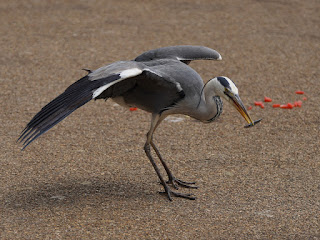The Little owlets at the Round Pond are now coming out of the nest hole, but unfortunately I couldn't get a picture of one. Their father had hidden them very efficiently in a horse chestnut where they could be heard but not seen. When I got near the tree he yelled at me, so I backed off.
Two male Blackbirds near the Dell were unusually close to each other without conflict. One gathered worms for fledglings, the other sang on a branch above.
The one on the branch also had a fledgling.
There was a family of Wrens in the bushes in the Rose Garden.
Not all the young Starlings are independent yet. Ahmet Amerikali photographed a Starling collecting insects for his young.
He also got this remarkable shot of a Jay catching insects in midair.
A Jackdaw had a family in a nest hole near the Physical Energy statue.
The Peregrines were even closer together on the barracks tower. They almost look fond of each other.
I was surprised to see how many birds liked pieces of watermelon that were being thrown to them: a Carrion Crow ...
... a Coot ...
... and a Greylag Goose.
But a Grey Heron got the top prize of a fresh herring.
Another was doing its own fishing in the Italian Garden.
A young Cormorant had also been fishing at the island and was drying its wings.
The Coot on the menu-strewn nest at the Dell restaurant was given yet another piece of paper.
The eight Mallard ducklings have survived another day in the Italian Garden. They played in the water lilies.
Greylag Geese don't share childcare like Canadas do, but when they have young they do tend to keep together. These families were all within a few yards of each other on the south shore of the Serpentine.



%202023%201a.jpg)
%202023%201a.jpg)










Happy Father’s Day Little Owl!
ReplyDeleteSean
How pretty, the Heron among the water lilies!
ReplyDeleteI didn't know Little Owl parents hid their owlets - I suppose they'll sternly tell them to stay put and not jump around.
What a strange way to position one's flight feathers. I wish we could question the Jay on technique.
Tinúviel
I think that Jay's wings are on the upstroke, letting as much air as possible through to reduce drag. The feathers will close together on the downstroke to achieve the opposite. There must be a slow motion film of bird flight somewhere with appropriate aerodynamic information, but I've never seen one. You can't fault a Jay on technique: they are wonderful aerial performers.
DeleteWatermelon does seem an unlikely cross species favourite. I'm betting you'll have shots of the owlets by the end of the week!
ReplyDeleteStill no luck today despite two visits.
Delete[Putting this comment here because once again it won''t let me comment on today's entry]
ReplyDeleteDon't let Bumblebees hear you call them an ordinary lot!
I'm sure I've asked this before, but is there any reason why young Wagtails, well, wag their tails so pronouncedly in comparison to adult Wagtails?
Tinúviel
I think it's Grey Wagtails that wag more than Pied ones, rather than age-related.
DeleteAnd, on the subject of disallowed comments, I am moving towards making Yandex my default browser. It ignores such obstacles with the aplomb of a T-72. I am testing all the sites I generally use, and it hasn't failed yet, where Chromium is struggling more and more.
DeleteAs soon as I learn how to force Yandex to do what I want and not what it wants cookies- and privacy-wise, I'm switching as well. It can handle almost anything, with ruthless efficiency.
DeleteTinúviel
It has an enormous menu of settings. I've just discovered the ones that stop it telling you the weather in Moscow, in Russian. So far I haven't discovered anything it won't do, and the recommended Adguard ad-blocker extension seems to work well.
Delete